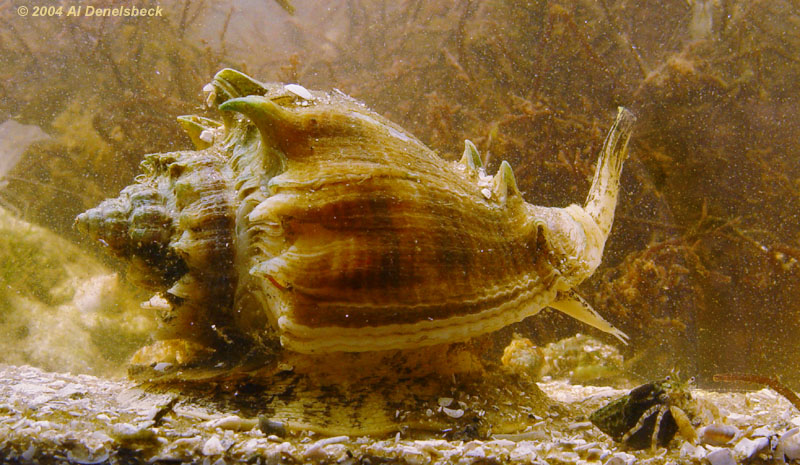Right: Sony F-717 digital
9.7mm at f8
1/125 second, ISO 100
Below: Canon Elan IIe, tripod
380EX flash
Sigma 105 Macro
Fuji Provia 100F
Exposure unrecorded
|
Right: Sony F-717 digital |
| Escargot | |
 |
|
It was generally easy to catch a variety of snails, all quite small – the shells were about the size of someone's fingernail. But then there are a few much bigger ones as well, measuring from 4 to 8 cm in length (1.5 to 3 inches). I eventually learned these were king's crown conchs (Melongena corona), also called common, American, and Florida crown conchs, and that they're not conchs at all. True conchs are herbivorous; these guys are not.
In the image above, it's easy to see several anatomical details, such as the siphon tube extending up, the head with antennae and eyespots, and the broad pedestal-like foot – and just to the right of it, one of the smaller varieties of hermit crabs. Hermit crabs, of course, use empty snail shells as protection, so you can get some idea of the disparity in size.

I had witnessed some amazing contortions by snails as they encountered one another, sometimes rolling or gyrating away from contact, and I'm guessing they were assisted by expelling water. So apparently there's a certain bad element to contact between snails, either of differing species or at the wrong time.
One of the smaller ones, however, didn't get out of the way of my big species in time when both were cruising the aquarium acrylic. I vaguely suspected an amorous embrace when I witnessed this, pondering whether I was seeing snails mate, but afterwards I found an empty snail shell on the sand directly beneath this spot. Later I found out that king's crown conchs are carnivorous, which removed all doubt.
My tank was too small to sustain a snail of this size, so after about two weeks, and several photos, I let it go back in the river.
